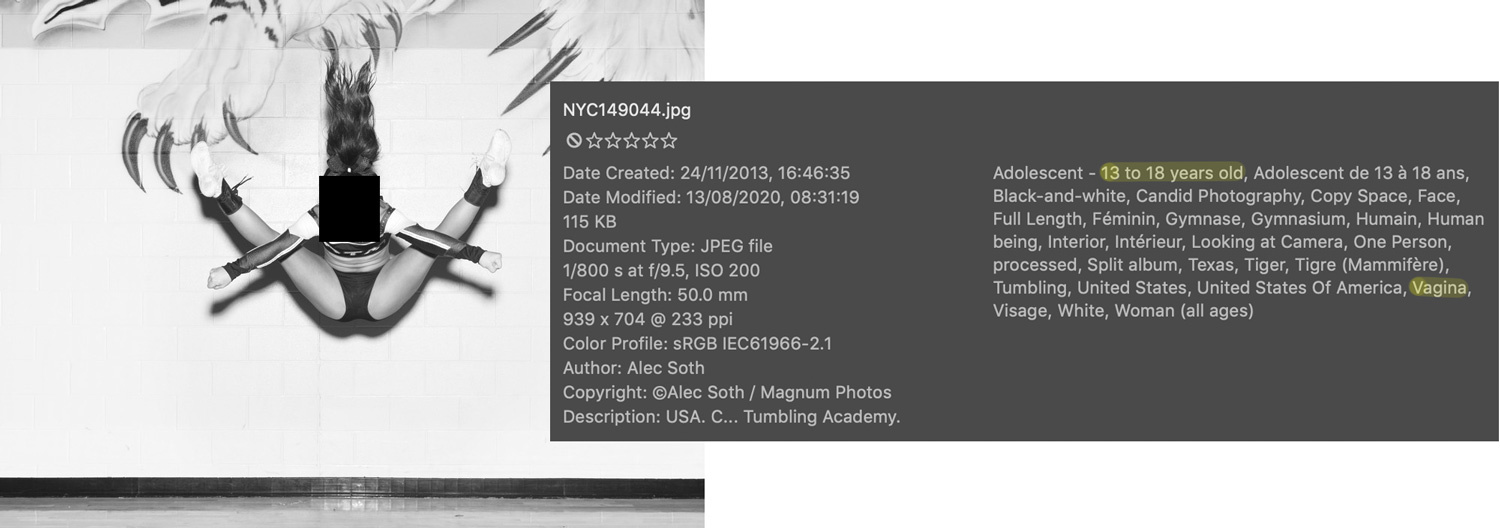Magnum Photos, a world-leading photojournalist agency, briefly shut down its archive and has now begun an ‘in-depth internal review’, to discover potentially ‘problematic… imagery, captioning or keywording’.

UPDATE 21/8/2020: Magnum has suspended American photojournalist, David Alan Harvey, over new allegations that he ‘harassed a female colleague’, which are unrelated to his controversial 1989 Bangkok series. The Magnum board voted unanimously to suspend Harvey’s membership while it investigates the allegations. Details of the allegations have not been made public, however they would represent a breach of Magnum’s Code of Conduct. Here’s the statement Magnum provided to The Guardian. ‘
A specific allegation has been made in confidence over the past few days relating to the personal conduct of David Alan Harvey. Such behaviour would represent a breach of [Magnum’s] code of conduct. A formal investigation is being carried out and David Alan Harvey’s membership has been suspended whilst this process takes place.
Magnum is committed to a safe work environment and we will fairly and thoroughly investigate allegations of improper conduct by photographers or staff.
Magnum reiterated to Petapixel the suspension has no connection with the 1989 photos, which Harvey denied depict sexually exploited children.
Last week Inside Imaging reported a photo series from 1989 of sex workers in Bangkok, by accomplished American photojournalist David Alan Harvey, showed topless female nudity and didn’t obscure faces. The now-deleted series also showed clothed child sex workers in the streets.
The photo at the centre of attention shows a topless female sex worker in a bedroom, and included dubious search engine key words – ‘Prostitute’, ‘Breast’, and ‘Teenage girl – 13 to 18 years’. The latter key word insinuates the subject may be underage, a child sex worker, and is the basis for accusations that Magnum has been licensing photos of alleged child pornography.
It’s unknown whether the partially naked subject, captured over 30 years ago, was actually underage at the time. The evidence stems from the key wording, and the agency hasn’t made it clear how these words are generated. The archive consists of almost one million photos available for licence, including the now-deleted images discovered by searching for ‘girl’ and ‘prostitute’. There are a number of ways Magnum may generate its key words, including automation through AI, outsourced cheap to an offshore third-party, handled by staff or interns, or filed by the photographers themselves.
Magnum was alerted to the ‘problematic photos’ and captioning by Fstoppers senior writer, Andy Day, who demanded Magnum Photos answer his questions or else it’s ‘function as a photographic agency should be regarded as untenable’. Magnum since removed keywords from its archive, however Day (or someone in his Twitter gang) started fossicking through image metadata to find more sexual key words.
Day reported that an image by Alec Soth, of a clothed cheerleader doing a split jump (below), includes a tag for female genitalia. Despite a disturbing and mystifying key word, it’s evident that Magnum’s tags are flawed and don’t accurately convey the information in the photo. So do key words then form a reasonable basis of Day’s accusations of child abuse/exploitation/pornography, or are they simply a mismanaged and overlooked aspect of Magnum’s archive?

While the agency has valiantly defied to respond to Day’s questions, Magnum Photos president, Olivia Arthur, released a lengthy letter flagging a review. Here is the full statement:
Dear Magnum Community,
Our photographic world is entering an unprecedented period of self-reflection. Many of us are starting to look at ourselves and our work from points of view that we had previously overlooked. I am happy to have seen Magnum dedicate time and effort in the past few years to really thinking about who we are and how we represent the world from both sides of the camera. I fully acknowledge that we are on a journey with plenty of road ahead of us.
Recently, we have also been alerted to historical material in our archive that is problematic in terms of imagery, captioning or keywording and we are taking this extremely seriously. We have begun a process of in-depth internal review – with outside guidance – to make sure that we fully understand the implications of the work in the archive, both in terms of imagery and context.
That being said, we don’t want to dismiss or underestimate the role of photographers (both historically and currently) to go out into the world to document important global, political and social issues. As documentarians, my colleagues have been recording and commenting on global issues for nearly 75 years. In that period standards for what has been acceptable have evolved. Issues and questions that were previously overlooked, have to be addressed. That’s a good thing. With this review of the archive we do not want to undo historical work but make sure that we understand the full ethical considerations. Some cases will be clear cut, others will not be easy decisions, full of grey zones.
It is a huge archive with many authors and we want to conduct this review both thoroughly and reasonably, so it will no doubt be a lengthy process.
We at Magnum always welcome the scrutiny and feedback of the public and our friends in the photographic community, whether it is positive or negative. Most of us have spent our lives trying to use photography to question and interrogate society around us – and I hope we will never stop doing that inside our organisation as well.
Olivia Arthur, President, Magnum Photos
This is, of course, not enough for Day, who seems hellbent on bringing Magnum, ‘photography’s elite gatekeepers’, on its knees and begging for forgiveness. In FStoppers latest report, Day claims Arthur’s statement falls short because there is ‘no apology, no contrition, and no mention of the sexually explicit images of what appear to be children’; he slams mastheads like The New York Times for remaining silent over fears of undermining ‘long-standing friendships built on years of mutual backscratching’; he fires shots at Wired Italia for being critical of his two hit pieces, and suggests its publisher, Conde Naste, may want to pull its editors in line; and he concludes ‘photojournalism simply cannot give sex offenders a means of gaining access to vulnerable children’.
We didn’t quite make the final cut, however Andy Day does have accusations to hurl at our coverage. In a Tweet, he compliments Inside Imaging‘s ‘impressive use of speech marks’ and then claims it’s ‘clear that they (Inside Imaging) don’t have a problem with sexually explicit images of children’. Perhaps Day needs to attend a journalism crash course, where they teach how quotation marks are used to attribute sources. While such grave accusations for balanced reporting would ordinarily come at a shock, this knee-jerk reaction from people like Day is sadly a new standard among activists cloaked as journalists. We expect another accusation is coming our way for this article, which dared point out flaws in Day’s accusations.
Some impressive use of speech marks from Inside Imaging throughout. It’s clear that they don’t have a problem with sexually explicit images of children. https://t.co/9BjuMLJGRT
— Andy Day (@kiell) August 14, 2020





Magnum goes Woke. Sad day for objective photojournalism.
Every single thing about a photo is a choice. communicating a feeling, a thought, a perspective, a political idea. There’s no such thing as objective photojournalism – it’s only considered objective when it’s a white man’s viewpoint.
why are you a fan of racism, misogyny, and homophobia? you should be ashamed.
Please explain what led you to that conclusion, Jasper?
“It is not enough for journalists to see themselves as mere messengers without understanding the hidden agendas of the message and the myths that surround it” – John Pilger